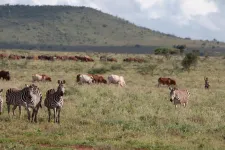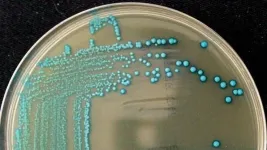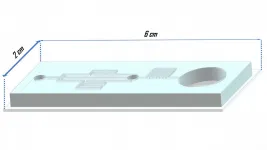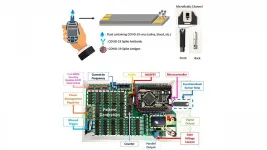(Press-News.org) In quiet moments, the brain likes to wander—to the events of tomorrow, an unpaid bill, an upcoming vacation.
Despite little external stimulation in these instances, a part of the brain called the default mode network (DMN) is hard at work. "These regions seem to be active when people aren't asked to do anything in particular, as opposed to being asked to do something cognitively," says Penn neuroscientist Joseph Kable.
Though the field has long suspected that this neural network plays a role in imagining the future, precisely how it works hadn't been fully understood. Now, research from Kable and two former graduate students in his lab, Trishala Parthasarathi, associate director of scientific services at OrtleyBio, and Sangil Lee, a postdoc at University of California, Berkeley, sheds light on the matter.
In a paper published in the Journal of Neuroscience, the research team discovered that, when it comes to imagining the future, the default mode network actually splits into two complementary parts. One helps create and predict the imagined event, what the researchers call the "constructive" function. The other assesses whether that newly constructed event is positive or negative, what they call the "evaluative" function.
"It's a neat division," says Kable. "When psychologists talk about why humans have the ability to imagine the future, usually it's so we can decide what to do, plan, make decisions. But a critical function is the evaluative function; it's not just about coming up with a possibility but also evaluating it as good or bad."
Building on previous work
The DMN itself includes the ventromedial prefrontal cortex, posterior cingulate cortex, and regions in the medial temporal and parietal lobes, such as the hippocampus. It's aptly named, Kable says. "When you put people into a brain scanner and ask them to not do anything, to just sit there, these are the brain regions that seem to be active," he says.
Previous research had revealed which areas make up the DMN and that constructing and evaluating imagined events activates different components. Kable wanted to test that idea further, to better pinpoint the implicated regions and what's happening in each.
To do so, he and his team created a study in which 13 females and 11 males received prompts while in a functional magnetic resonance imaging (fMRI) machine. Participants had seven seconds to read one of 32 cues such as, "Imagine you're sitting on a warm beach on a tropical island," or "Imagine you win the lottery next year." They then had 12 seconds to think about the scenario, followed by 14 seconds to rate vividness and valence.
"Vividness is the degree to which the image that comes to mind has a lot of details and how much those details subjectively pop as opposed to being vague," Kable says. "Valence is an emotional evaluation. How positive or negative is the event? Is this something you want to have happen or not?"
Participants went through the process four times. Each time, the Penn researchers watched brain activity from the fMRI. The work confirmed two sub-networks at play.
"One network, which we'll call the dorsal default mode network, was influenced by valence. In other words, it was more active for positive events than for negative events, but it was not influenced at all by vividness. It seems to be involved in the evaluative function," Kable says.
The other sub-network, the ventral default mode network, was more active for highly vivid events than for events with no detail. "But it wasn't influenced by valence," he says. "It was equally active for both positive and negative events, showing that network really is involved in the construction piece of imagination."
Next steps
According to Kable, the findings offer a first step toward understanding the basis of imaginative abilities. This research asked participants to evaluate the positivity or negativity of an imagined event, but more complex assessments—moving beyond the simple good-versus-bad dimension, for instance—might offer further clues about this neural process.
That kind of analysis will likely comprise future work for the Kable lab, which has already begun using these findings to parse why people don't value future outcomes as much as immediate outcomes.
"One theory is that the future isn't as vivid, isn't as tangible and detailed and concrete as something right in front of your face," he says. "We've started to use our identification of the sub-network involved in construction to ask the question, how active is this network when people are thinking about future outcomes compared to the same outcome in the present."
And although the research was completed before COVID-19, Kable sees pandemic-related implications for these findings. "If you described what someone's life was going to be like to them before the pandemic hit—you're going to work from home and wear a mask every time you go outside and not engage in any social contact—it would blow their mind. And yet, once we have the actual experiences, it's no longer so strange. For me, this demonstrates that we still have far to go in understanding our imaginative capabilities."
INFORMATION:
Funding for this research came from the National Institute of Drug Abuse of the National Institutes of Health (Grant R01 DA029149).
Joseph Kable is the Baird Term Professor in the Department of Psychology in the School of Arts & Sciences at the University of Pennsylvania. He is also director of MindCORE, Penn's hub for the integrative study of the mind.
SAN DIEGO (May TK, 2021) - Compared to most other bear species, very little is known about how female Andean bears choose where they give birth to cubs. As a critical component of the reproductive cycle, birthing dens are essential to the survival of South America's only bear species, listed as Vulnerable on the International Union for Conservation of Nature (IUCN) Red List of Threatened Species.
A new study led by Russ Van Horn, Ph.D., published April in the journal Ursus, takes the most detailed look yet at the dens of this species. Van Horn, a population sustainability scientist, leads San Diego Zoo Wildlife Alliance's Andean bear conservation program. He was joined by colleagues from the University of British Columbia's Department of Forest ...
A large survey of women in California shows significant racial and ethnic differences in the types of personal care products women use on a daily basis. Because many personal care products contain endocrine disrupting chemicals (EDCs) like parabens and phthalates that interfere with the body's hormones, the findings could shed light on how different products influence women's exposures to harmful chemicals that contribute to health inequities.
The study appears in the Journal of Exposure Science & Environmental Epidemiology as part of a special issue focused on health equity. ...
In the midst of a devastating global pandemic of wildlife origin and with future spillovers imminent as humans continue to come into closer contact with wildlife, infectious-disease models that consider the full ecological and anthropological contexts of disease transmission are critical to the health of all life. Existing models are limited in their ability to predict disease emergence, since they rarely consider the dynamics of the hosts and ecosystems from which pandemics emerge.
Published May 17 in Nature Ecology and Evolution, Smithsonian scientists and partners provide a framework for a new approach to modeling infectious diseases. It adapts established methods developed to study the planet's natural systems, including ...
LA JOLLA--(MAY 18, 2021) Despite only accounting for about 1 percent of skin cancers, melanoma causes the majority of skin cancer-related deaths. While treatments for this serious disease do exist, these drugs can vary in effectiveness depending on the individual.
A Salk study published on May 18, 2021, in the journal Cell Reports reveals new insights about a protein called CRTC3, a genetic switch that could potentially be targeted to develop new treatments for melanoma by keeping the switch turned off.
"We've been able to correlate the activity of this genetic switch to melanin production and cancer," says Salk study ...
Nearly 15 percent of the U.S. population experiences migraine. One subtype of migraine that is not well understood is migraine with aura (MA). Individuals who experience MA often see flashing lights, blind spots, or jagged lines in their visual field prior to onset of their migraine headaches. Individuals who experience MA also face a heightened risk of stroke and cardiovascular disease, although scientists continue to explore why this correlation exists. In a new study from Brigham and Women's Hospital, researchers used a technique in genetic analysis termed Mendelian randomization to examine 12 coagulation measures, uncovering four that are associated ...
For the first time, researchers can quantitatively predict blood flow conditions that likely cause pathological behavior of the human blood protein von Willebrand factor (vWF). Predictions from this new method of simulation, developed at Lehigh University, can be used to optimize the design of the mechanical pumps known as left ventricular assist devices used in heart failure patients. The method also has the potential to improve diagnosis and treatment of von Willebrand disease, the most common inherited bleeding disorder in the U.S., according to the Centers for Disease Control and Prevention. The article, "Predicting pathological von Willebrand factor unraveling in elongational flow," appears ...
A new study of ancient DNA from horse fossils found in North America and Eurasia shows that horse populations on the two continents remained connected through the Bering Land Bridge, moving back and forth and interbreeding multiple times over hundreds of thousands of years.
The new findings demonstrate the genetic continuity between the horses that died out in North America at the end of the last ice age and the horses that were eventually domesticated in Eurasia and later reintroduced to North America by Europeans. The study has been accepted for publication in the journal Molecular Ecology and is currently available ...
ITHACA, N.Y. - While examining the prevalence of listeria in agricultural soil throughout the U.S., Cornell University food scientists have stumbled upon five previously unknown and novel relatives of the bacteria.
The discovery, researchers said, will help food facilities identify potential growth niches that until now, may have been overlooked - thus improving food safety.
"This research increases the set of listeria species monitored in food production environments," said lead author Catharine R. Carlin, a doctoral student in food science. "Expanding the knowledge base to understand the diversity of listeria will save the commercial food world confusion and errors, as well as prevent ...
WASHINGTON, May 18, 2021 -- What are the most delicate and valuable things you have handled? How would you feel if your daily job involved handling human eggs and any mistakes would affect someone's life?
Typical egg collection requires a healthy woman to go through weeks of hormone therapy and then undergo an operation to retrieve eggs. These hard-earned and precious eggs are fertilized in vitro, and the best embryos are selected for future transfer.
But not all transfers succeed, which gives rise to the practice of freezing the extra embryos from an IVF cycle for future ...
WASHINGTON, May 18, 2021 -- The COVID-19 pandemic made it clear technological innovations were urgently needed to detect, treat, and prevent the SARS-CoV-2 virus. A year and a half into this epidemic, waves of successive outbreaks and the dire need for new medical solutions -- especially testing -- continue to exist.
In the Journal of Vacuum Science & Technology B, researchers from the University of Florida and Taiwan's National Chiao Tung University report a rapid and sensitive testing method for COVID-19 biomarkers.
The researchers, who previously demonstrated ...




